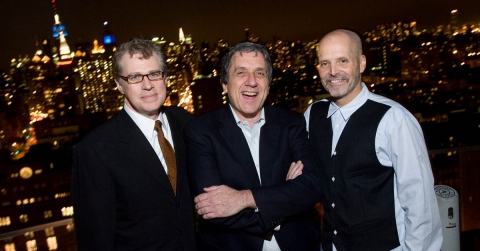On January 12, 2010, an earthquake struck the Caribbean nation of Haiti 10 miles west of the capital, Port-au-Prince, damaging nearly 190,000 houses and displacing some 500,000 people. In November 2011, Nonesuch Records staffer Stephanie Bauman joined four fellow Warner Music Group employees for the 28th annual Jimmy and Rosalynn Carter Habitat for Humanity work project in Léogâne, Haiti. She and the WMG team joined President Carter and 400 other volunteers from all over the US in helping to rebuild. Read about Stephanie's unforgettable experience here and see photos from the project.
On January 12, 2010, an earthquake struck the Caribbean nation of Haiti 10 miles west of the capital, Port-au-Prince, damaging nearly 190,000 houses and displacing some 500,000 people. A little over a year later, in the spring of 2011, Nonesuch Records staffer Stephanie Bauman received an e-mail from Warner Music Group, the label's parent company, with the news that they would be sponsoring four of their employees to participate in the 28th annual Jimmy and Rosalynn Carter Habitat for Humanity work project in Léogâne, Haiti. Stephanie applied, was accepted, and, on November 6, found herself on a plane in the company of President Carter and 400 other volunteers from all over the country. The Nonesuch Journal asked her to share some of her memories of this very special experience.
"My experience in Haiti was profoundly powerful," Stephanie recounts, "its impact too large and complicated to capture in a single report. Instead of trying to wrap up my experience in a concise summary essay, I thought I would expand on a journal entry from my first day arriving in Léogâne."
Here is that journal entry. For photographs from the project, go to nonesuch.com/media.
6 November 2011
It’s been a very long, unforgettable day. We landed in Port-au-Prince and were shuffled onto different buses for the ride to our campsite. The buses, as I later learned, were all rented from the Dominican Republic, as there are scarce resources left in this ravaged country. As much as Habitat had warned us for our first glimpses of Haiti, I was still unprepared.
For a distance of a mere 30 miles, our drive to the campsite took an excessively long two hours. Initially everyone on my bus was busy getting acquainted, greeting one another and sharing hopes for the week ahead. But then we pulled out of the driveway and onto a main road—the chatter came to a startling halt. All eyes were focused on the view beyond the windows.
The only word to describe Haiti’s current landscape is post-apocalyptic. It’s not simply that the country is poor and lacking secure homes, schools and clean water—it truly looks as though the country has been torn to shreds. Cars litter roads in broken chunks, apartment buildings lay crumbled on the ground in a chaotic mess and sewers are overflowing with polluted, oil-slicked water. So while I thought I would be prepared for anything, I found I was sorely mistaken. My eyes filled with tears.
As our days unfolded I realized that the complete lack of infrastructure was perhaps the greatest challenge for future development. This fundamental structural issue was upsetting and a depressive obstacle for maintaining a healthy hope. How will Haitians find employment opportunities and secure homes for their families when there is nowhere to work and nowhere safe to live? Especially on that first day it felt that I was facing (that we were all facing) a challenge that could never be accomplished.
I think it’s probably common to feel a rush of defeat in the face of extreme need. But as one becomes better informed and situated within a given circumstance intellectually, emotionally and experientially, one can find his or her place in the overwhelming scale of the disaster. Getting to know the community who will benefit from shared effort is the very best way to accomplish this. In this case, I was especially eager to get started on construction, as we would be working alongside the Haitian homeowners who would eventually be moving into the hurricane-proof homes with their families.
Later we arrived at the campsite, were given tent assignments and started to become acquainted with the staff and structural surroundings. Later in the evening President and Mrs. Carter invited us to gather for a welcome ceremony that included greetings and dances by Habitat colleagues and Haitian friends. A beautiful spirit was on display as we all gathered together, for the first time, in honor of restoring Haiti’s future.
Settling in to sleep, I imagine what tomorrow will bring and I suddenly feel a sense of urgency and a surge of energy. We will build 100 houses by the week’s end. Our work is just a step towards the beginning of a long and complicated recovery, but a critical one that will help lead the way to a brighter future for Haiti.
"Now, having returned home some months ago," Stephanie says today, "I would like to take this opportunity to send a very big and humble thanks to Warner Music Group for this tremendous opportunity. My trip to Haiti began as an unknown journey to a country whose devastation felt impenetrable and ended as one of the most important and rewarding experiences of my life. And it is because of this experience that I have been given the opportunity to become a Habitat Volunteer Leader for groups traveling to Haiti on work trips in the future. Thank you so very much to Warner Music Group and to my WMG peers who lived and worked beside me and kept me strong along the way. We might have been a scrappy team, but we were a scrappy team with a whole lot of spirit!"
For more information on Habitat for Humanity's efforts in Haiti and to discover more about volunteering, please visit habitat.org.
- Log in to post comments



